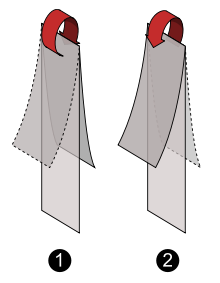Double fold (paper testing)
- Double fold (paper testing)
-

How a double fold is made using a test piece (seen from the side).

A double fold is made by first folding the test piece backwards and then forwards to its initial position (one complete oscillation).
A double fold is when a paper sample is folded first backwards and then forwards about the same line, i.e. one complete oscillation. The number of double folds that is required to make a test piece break is used to determine the material's folding endurance and fold number.
The total folding angle (about the folding line) differs depending on which folding tester is used, for instance the Köhler–Molin instrument folds about 156° on each side of the vertical line, resulting in a complete oscillation of about 2 × 312° for each double fold, while the MIT instrument employs a folding angle of about 135° on each side (that is, a complete oscillation of about 2 × 270° for each complete double fold).[1]
Strictly speaking, the first double fold is more than one complete oscillation since the flap needs to be folded from vertical to its starting position before the counting begins.
Sources
- ^ ISO 5626:1993 Paper – Determination of folding endurance, Annex A
Wikimedia Foundation.
2010.
Look at other dictionaries:
Double Fold — For the term double fold used in paper testing, see Double fold (paper testing) Double Fold: Libraries and the Assault on Paper is a non fiction book by Nicholson Baker that was published in April, 2001. An excerpt appeared in the July 24, 2000… … Wikipedia
Mummy paper — is paper that is claimed to be made from the linen wrappings and other fibers (e.g. papyrus) from Egyptian mummies imported to America circa 1855.[1] The existence of this paper has not been conclusively confirmed, but it has been widely… … Wikipedia
Mass deacidification — is a term used in Library and Information Science for one possible measure against the degradation of paper in old books (the so called slow fires ). The goal of the process is to increase the pH of acidic paper on a large scale. Although acid… … Wikipedia
Preservation (library and archival science) — Preservation is a branch of library and information science concerned with maintaining or restoring access to artifacts, documents and records through the study, diagnosis, treatment and prevention of decay and damage. [cite web… … Wikipedia
South Africa — Republic of, a country in S Africa; member of the Commonwealth of Nations until 1961. 42,327,458; 472,000 sq. mi. (1,222,480 sq. km). Capitals: Pretoria and Cape Town. Formerly, Union of South Africa. * * * South Africa Introduction South Africa… … Universalium
environment — environmental, adj. environmentally, adv. /en vuy reuhn meuhnt, vuy euhrn /, n. 1. the aggregate of surrounding things, conditions, or influences; surroundings; milieu. 2. Ecol. the air, water, minerals, organisms, and all other external factors… … Universalium
education — /ej oo kay sheuhn/, n. 1. the act or process of imparting or acquiring general knowledge, developing the powers of reasoning and judgment, and generally of preparing oneself or others intellectually for mature life. 2. the act or process of… … Universalium
Business and Industry Review — ▪ 1999 Introduction Overview Annual Average Rates of Growth of Manufacturing Output, 1980 97, Table Pattern of Output, 1994 97, Table Index Numbers of Production, Employment, and Productivity in Manufacturing Industries, Table (For Annual… … Universalium
MythBusters (2007 season) — Country of origin Australia United States No. of episodes 25 (includes 4 specials) Broadcast Original channel Discovery Channel … Wikipedia
United Kingdom — a kingdom in NW Europe, consisting of Great Britain and Northern Ireland: formerly comprising Great Britain and Ireland 1801 1922. 58,610,182; 94,242 sq. mi. (244,100 sq. km). Cap.: London. Abbr.: U.K. Official name, United Kingdom of Great… … Universalium


